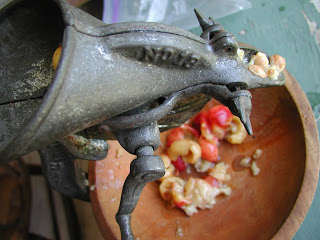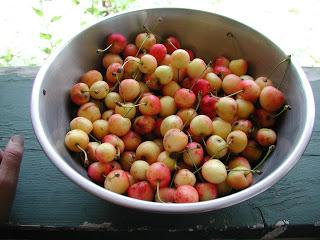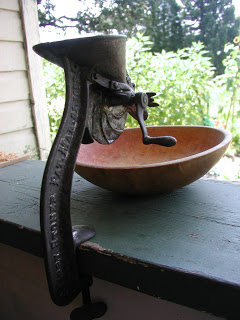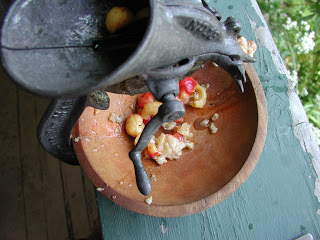After many years of spending hours with a handheld cherry pitter, I listened with great interest whenever I heard tales of the cast-iron hand cranked cherry stoners of days gone by. Where were these contraptions to be found and why wasn’t everyone using them today? The idea of simply feeding in cherries and turning a crank to separate fruit from stone made much more sense than hours of punching the little hand-squeezed utensil with sticky, slippery cherry juice covered fingers. There was no sense in it as far as I could see. So, imagine my excitement one day when a friend offered to let me borrow an antique cherry stoner they had dug out while cleaning their shop. It was in fine working order, and only needed minor cleaning up, so I went out and got busy picking on a neighbor’s cherry trees.
While trying to figure out exactly how to work this miraculous piece of kitchen equipment, we stumbled across an excellent article by Lucie Snodgrass which I have to say is a must-read: My Curvaceous Cast-Iron Beauty . This saucy nickname for the cherry stoner stuck, and I will forever refer to it as such. I took that beauty home, clamped it onto my front porch rail so the chute for the pits pointed out into the garden, and got a wooden bowl set up underneath to catch the fruit. I got the crank spinning forward and began feeding in cherries and watching the pits shoot out into the garden bed below.
I have to report that it was really as simple as it seemed. Nothing about it was too good to be true. The cherries did come out a bit less whole and perfect then when I’ve hand pitted them in years past, but that was a small price to pay for the speed and efficiency. Two quarts took a mere five minutes! I could have easily done pounds upon pounds of cherries without eating up the entire day.




No more stained fingers!
What are you going to do with all that nummy cherry flesh? Are you canning Rainiers?
I froze them for the coldest days of winter when cherries will be the most exciting of treats!